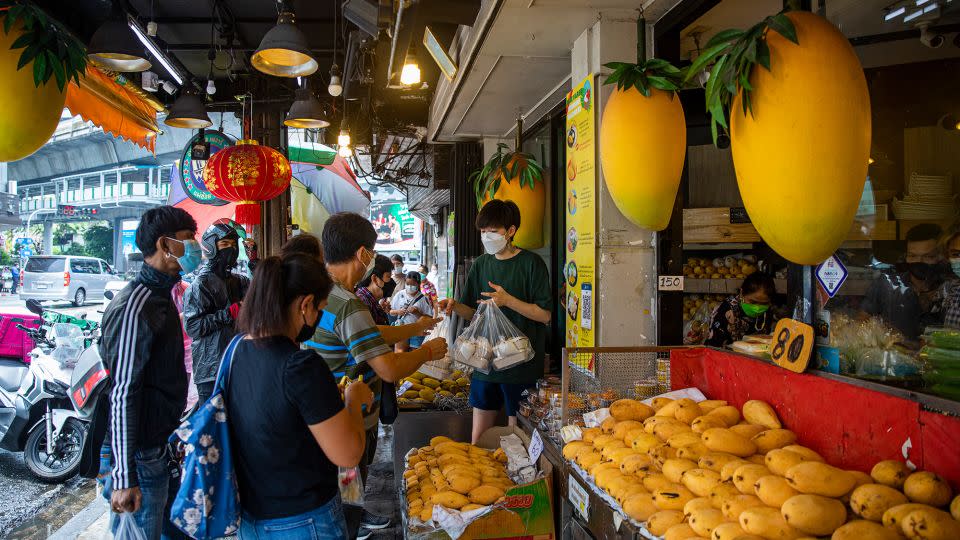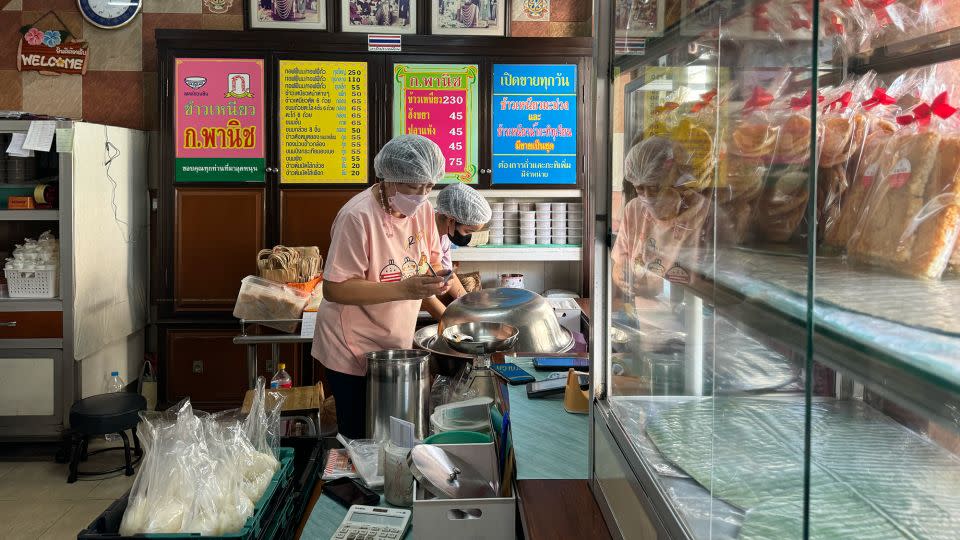Why mango sticky rice is one of Thailand’s most beloved summer dishes
Editor’s Note: This CNN Travel series is, or was, sponsored by the country it highlights. CNN retains full editorial control over subject matter, reporting and frequency of the articles and videos within the sponsorship, in compliance with our policy.
There are said to be more than 200 types of mangoes grown in Thailand.
But when it comes to creating one of the country’s most beloved desserts, khao nieow mamuang, connoisseurs say few varieties will do.
Better known to the rest of the world as mango sticky rice, it’s a deceptively simple dish.
Slices of sweet, ripe mango are set next to a mound of glutinous rice that’s topped with a coconut-based cream sauce and a light sprinkling of yellow mung beans.
If done right, the result is pure magic, the perfect balance of flavors and textures.
And few have perfected that balance as well as 63-year-old Varee Jeensuwan, the undeniable queen of mango sticky rice in Bangkok.
Her shop in Bangkok’s busy downtown Thonglor neighborhood, Mae Varee, has been operating since 1981.
“The best dessert during summertime in Thailand is mango and sticky rice,” she tells CNN.

“From March to May is the best time of the year to have it – the mangoes will be naturally sweet and abundant, the price is low. The sticky rice is aromatic due to its freshness.”
Thailand’s nam dok mai (water of the flower) mangoes are the most popular variety for the dish, as they possess a sweet flavor and smooth texture. Varee says some of the best nam dok mai mangoes are found in Chacheonseo province’s Bangkhla district.
Another popular variety used in mango sticky rice is Oak Rong, which she says has to come from Damnoen Saduak district in Ratchaburi province.
“It is difficult to find, and only available a little bit in January and more in March and April,” she says.
“Oak Rong is only famous among Thais, most foreigners are not familiar with this variety. They know Nam Dok Mai.”
Though mangoes play the starring role in khao nieow mamuang, the other ingredients are just as important, says Varee.
In her shop, they use sticky rice grains specially selected from Thailand’s northernmost province, Chiang Rai. Coconuts come from Suratthani province, in the south, as they must have an intense flavor that complements the sticky rice. The yellow mung beans are baked, not fried, to give the dish a slight crisp.
“Even the salt used in the cream, we order it from Samut Sakorn,” she says, referring to a coastal province south of Bangkok.
As for their customer base, she says they cater to a mix of Thais and foreign tourists.
“I would say most of my foreign customers are from China, Hong Kong and Singapore,” says Varee. “When they are here, they will have to check-in on social media in front of my shop. They said if they visit Thailand and don’t check-in, they are not really in Thailand yet.”
The Milli effect
It’s impossible to talk about Thailand’s love for khao neao mamuang without mentioning popular young Thai rapper Milli, whose real name is Danupha Khanatheerakul.
In 2022, she performed at the Coachella music festival in California and ended her show by digging into a bowl of mango sticky rice.
The act ignited a nationwide craving for the dish back in Thailand. In Bangkok, images on social media and news sites showed the city’s most famous mango sticky rice shops suddenly being inundated with orders, evidenced by the lineups of delivery service drivers waiting outside.

Among those to benefit from the Milli effect was K Panich. One of the oldest purveyors of mango sticky rice in the city, it first opened in 1932, just a 15-minute walk from the Grand Palace, a popular historic attraction.
A sign hanging at the entrance of this tightly-packed traditional shophouse hints at its culinary credentials – it’s received Michelin’s Bib Gourmand award every year since 2019, a nod to its good value and high quality.
During a recent weekday visit, a small crowd has already gathered by 8:30 a.m., a mix of delivery drivers, local customers and foreign tourists sitting on wooden stools near the counter outside waiting for their orders. Tables, baskets and crates are piled high with bright yellow Nam Dok Mai mangoes.
Those who want to eat their food onsite are brought to a smoothie shop across the street to sit and enjoy their mango sticky rice at one of its tables.
Khun Nan, a manager on site, tells CNN the secret to the shop’s longevity is their commitment to sourcing top ingredients from all over the country.
“We focus on the quality of the raw materials,” she says, noting that dozens of foreign tourists visit the shop each day.
For those who just want to buy whole, uncut mangoes, K Panich allows its suppliers to set up outside the shop and sell their wares. That includes Saowalak Chaimeesuk, 54. When asked why the tropical fruits are such a popular summer treat in Thailand, she says much of it has to do with nostalgia.
“In the old days we didn’t grow Nam Dok Mai all year, but now thanks to advances in agriculture we can have them during any season,” she says.
A fusion of culinary traditions
Mango sticky rice might be a popular street food, but it’s also a familiar site on dessert menus at high-end restaurants all over the country, with some featuring a modern twist.
Michelin-starred R-Haan in Bangkok, for instance, serves a refreshing nam dok mai mango parfait that maintains the flavors of the original. It’s served with coconut milk ice cream and a roasted pancake wrapped with candied coconut.
According to R-Haan co-owner/chef Chumpol Jangprai, there’s evidence suggesting mango sticky rice has been around since Thailand’s late Ayutthaya period (1351-1767), with references to the dish found in the centuries to follow.
“Recipes from King Rama V’s reign (1868-1910) mention ‘khao niew moon,’ which is glutinous rice steamed with sweetened coconut milk,” says the chef.
“This was likely served with various fruits, including mangoes. Although not native to Thailand, mangoes have been cultivated here for a long time. This readily available fruit became a natural partner for the sweet sticky rice.”
So while khao nieow mamuang might not be an ancient dessert, he says its history reflects the fusion of Thailand’s culinary traditions with readily available ingredients.
“It’s a testament to the ingenuity and deliciousness that Thai cuisine is known for,” says Chumpol.
For more CNN news and newsletters create an account at CNN.com
